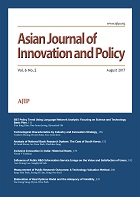4권 2호
초록
Abstract
Rural enterprise clusters in India have often been characterized by low-end products, poor income earning options and a near-absence of innovativeness. This has implied limited market access, inadequate organization of production and distancing from sources of formal knowledge. Policy neglect of rural industrialization notwithstanding this paper explores the nature of institutional constraints to innovation through intensive case studies of five rural artisan clusters (handlooms and handicrafts) in as many Indian states. Whether it relates to access to loan finance or technology support or linking to markets, the formal institutions (public or private) have been distanced by informality that typifies most rural enterprise clusters. An obsession with a sectoral approach to cluster development has negated addressing infirmities of the space of enterprise, even as scope for learning from some Asian economies in rural enterprise promotion exists. The paper also enquires if the innovation systems have been inclusive and pro-poor.
초록
Abstract
India faces a formidable challenge in ensuring security of access to modern energy carriers to majority of its population. The fossil-fuel dominated centralized energy system has proved to be ineffective in creating sustainable access to energy, which suggests need for a radical and innovative approach. We present such an approach. First, the need for innovations given the implications of lack of energy access on sustainable development is assessed. Next, possible innovations with respect to technologies, policies, institutions, markets, financial instruments and business models are discussed. Finally, an economic and financial feasibility of implementing such innovations are analyzed. The results indicate that such a proposal needs an investment of US$ 26.2 billion over a period of 20 years for a GHG mitigation potential of 213Tg CO2e. The proposition is profitable for the enterprises with IRRs in the range of 39%-66%. The households will get lifeline access to electricity and gas for cooking at an affordable monthly cost of about US$ 5.7.
초록
Abstract
This study provides a background on the growth of Indian automobile industry under different regulatory regimes. It is observed that the international joint ventures have played a key role in the growth of the sector. The study further examines the motives for forming IJVs in the auto component sector and also identifies the criteria for choosing the joint venture partner to mitigate conflicts. These two specific attributes form the core towards transfer of technology, promoting innovation and also act as a catalyst for adopting and choosing appropriate technology. The study brings out the relationship between motives, partner selection criteria and performance of the IJVs. Results indicate that firms gave maximum importance to technological skills, quality control measures and proprietary knowledge in selecting IJV partners. It is also observed that the motives affect the partner selection criteria in terms of skill and resources needed from the partner.
초록
Abstract
This paper empirically investigates the role of R&D intensity on market concentration of firms using four key market valuation variables, namely (1) market share, (2) labor intensity, (3) firm age and, (4) firm’s market value. The empirical tests use database at firm level for the Indian IT sector from 1999 to 2013 from the CMIE Prowess database. The results of the regression analyses partially support our hypothesis that R&D intensity positively influences firm’s market value measure by the H-index. The test results are consistent with the hypotheses that R&D spending is more valuable for firms with larger market shares, higher labor intensity, and firms that are diversified.
초록
Abstract
This paper, based on two engineering industry SME case studies, traces the origin and process of technological innovations enabling the development and introduction of new products leading to market expansion and enterprise growth. The study throws light on how entrepreneurs played a decisive role in recognizing market opportunities, building up crucial in-house technological capability, supplementing it with appropriate external assistance, to carry out technological innovations. A constant interaction with its customers is in-built into the system. As a result, the SMEs could achieve successful product innovations leading to their gradual growth, over time. Finally, based on the observations and inferences derived out of the two cases, a theoretical construct of the growth of innovation in SMEs is postulated. This is done linking the three stages of their development: (i) start-up and stabilizing, (ii) building up technological capability and implementing innovations; and (iii) opening up of new markets resulting in firm growth.
초록
Abstract
The relationship between geographical proximity and academics’ formal and informal knowledge-transfer activities in the network is analyzed with a mixed research method. With social network analysis as a basis, we have explored the networks between academics and firms in the 16 regions of South Korea. The result shows Seoul and Gyunggi are identified as central nodes, meaning that the academics in other regions tend to collaborate with firms in these regions. An econometric analysis is performed to confirm the localization of knowledge-transfer activities. The intensity of formal channels measured by the number of academic papers is negatively, but significantly associated with the geographical proximity. However, we have not found any significant relationship between the formality of the channels and geographical proximity. Possibly, the regional innovation systems in South Korea are neither big enough nor strong enough to show a localization effect.
초록
Abstract
Asian Journal of Innovation and Policy (AJIP) would like to introduce an interview section on innovations, innovators, and entrepreneurs if possible in every issue. The interviews introduced will be selected not based on a journalistic view, but rather by its theoretical or practical implications. This issue will introduce an entrepreneur who was a key engineer, Chief Technology Officer (CTO), and CEO of Samsung Electronics, in addition to being the Minister of ICT in the Korean government. Currently, he is the CEO of an investment company. His success was tied to the success of semiconductors at Samsung Electronics, which became the world leader, leading some to even call him “the god of semiconductors”. This interview resurrects the debates on the mode 2 society and the role of education in entrepreneurship.

